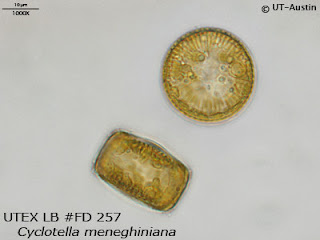After having met with Mr. Soderblom multiple times, and coordinated with various other researchers at the Dauphin Island Sea Lab (which originally studied the Deepwater Horizon spill in 2010), we settled on three possible species of diatom (a type of phytoplankton)(the Chaetoceros gracilis, Cyclotella meneghiniana, and Thalassosira) to culture for our experiments and ordered them from Carolina Biological Supply Co. Due to the weather, they got stuck in delivery and didn't end up arriving until 5 days after they had been shipped, meaning most of the plankton were dead.
Mr. Soderblom contacted the company and the representative redirected him to the manager, who promised to ship out new cultures of each species that day. As it turns out, the representative and the manager didn't coordinate well, and the representative took the liberty to overnight us a third supply of cultures the day after. So now we have double the amount of needed, viable diatom cultures!
Today we transferred each species of diatom to more permanent homes (aka, water bottles with Reverse Osmosis DeIonized (RODI) water, a very dilute solution of sodium metasilicate , which is a class-5 hazard, Instant Ocean saltwater mix and Micro Algae Grow). Because we received two sets of each species, we decided to run a little mini-experiment. One culture of each species will be aerated (meaning they'll have CO2 bubbled through their bottle) while the other will merely have the bottle cap loosened. Which ever method allows the best survival of the phytoplankton will be used in the actual experimentation.
Also, we don't plan on using all three species for the experiment, so we're running another mini-experiment. Whichever species survives and thrives the best given their current habitat will be used in the actual experimentation.
So far, we're hoping it'll be Cyclotella, because this species is the largest one at about 15 micrometers by 9 micrometers and therefore the easiest to observe. Below are pictures that we took through a microscope attachment of the algae compared to an advertised 50 x 50 micrometer (though the size looks to range from 40 to 60 micrometers) lattice of a one-layer material. Bot are at the 40x objective with an additional 25x viewing lens.
At the 10x objective, they look like this:
So still not incredibly large, but for unicellular organisms, that's pretty big. Here's what they look like from the side and above (taken from a Google search)
Signing off till next time, this is Erin Butcher.




Exciting start! Grow cultures, grow...
ReplyDeleteHow long will you grow them before polluting?
We're going to see which culture survives the best, and then continue to grow them for about another week before beginning contamination so we have a stable supply to pull from. All in all, we plan to start actual experimentation around February 13th .
Delete